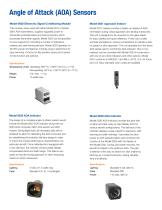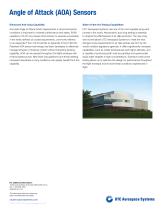
Catalog excerpts

Angle of Attack (AOA) Systems Precise, reliable measurement and display of Angle of Attack (AOA) from takeoff to landing can substantially improve aircraft performance as well as assure a safe operating margin above stall speed. Angle of attack is defined as the angle formed between the wing chordline and the direction of air flowing past the wing. At any specific AOA, the airflow over some percentage of the wing surface will generate lift as well as some amount of drag. Maximum lift is usually obtained at a relatively high angle. Where ingenuity takes off™ Stall is defined as the condition which arises when the angle grows so large that the flow is completely disrupted and not enough lift is generated to overcome the weight of the aircraft. This AOA, the stall angle, is constant for a particular aircraft, although various wing designs stall at differing angles. The amount of useful lift and drag generated by any wing at some specific AOA will depend upon the influence of such variables as the wing geometry, density altitude, aircraft gross weight and velocity. However, the ratio of lift to drag coefficients at a given angle remains constant. Therefore, the theoretically ideal ratio of lift and drag coefficients for any flight maneuver will always be found at the same AOA under all speeds or load conditions.
Open the catalog to page 1
Angle of Attack (AOA) Sensors Model 0012 AOA Transmitter This precision flow angle sensor is specifically suited for wing mounting on a conventional single-engine or multi-engine aircraft where a suitable fuselage location cannot be found. It features a pivoting swept-vane element extended on a boom from the wing’s leading edge, where it’s free of prop wash or other flow disturbances. For all-weather service, Model 0012 transmitters can be furnished with thermostaticallyregulated, 28-volt heaters for the vane, boom and nose cone. These heaters meet or exceed military specifications for...
Open the catalog to page 2
Model 0020 Electronic Signal Conditioning Module This module, when used with either Model 0012 or Model 0861 AOA transmitters, supplies regulated power to transmitter potentiometers and internal circuitry which processes transmitter signals. Model 0020 can be specified to have outputs for controlling a number of indicators, indexes and stall warning devices. Model 0020 operates on 28 VDC power and features modular, plug-in electronics for easy servicing. Circuitry for flap position inputs and a press-to-test function are optional. Specifications Temperature Limits Operating -65°F to +160°F...
Open the catalog to page 3
Enhanced Anti-Icing Capability Accurate Angle of Attack (AOA) measurement in all environmental conditions is important to maintain performance and safety. EASA updates to CS 25 now require AOA sensors to operate successfully in the newly defined ice crystal requirements, commonly referred to as Appendix P from CS 25 (similar to Appendix D from FAR 33). Patented AOA sensor technology has been developed to effectively manage all types of moisture content without impacting sensing capability. AOA can be sensed throughout the flight envelope with minimal added power. New fixed wing platforms...
Open the catalog to page 4All Collins Aerospace - UTC Aerospace Systems catalogs and technical brochures
-
FLIGHTHUB™
2 Pages
-
ARINC SELFSERV™
2 Pages
-
LED Indicator Signs
8 Pages
-
Boeing 787 Video System
4 Pages
-
Air Data Probes
4 Pages
-
Model 0851HL Pitot Probe
2 Pages
-
Pitot Probes 0851 Series
2 Pages
-
SmartProbe® Air Data Systems
4 Pages











